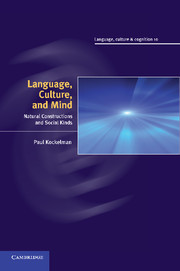Book contents
- Frontmatter
- Contents
- List of illustrations
- Acknowledgements
- 1 Language, culture, mind: emblems of the status human
- 2 Inalienable possessions: what hearts, mothers, and shadows have in common
- 3 Interclausal relations: how to enclose a mind by disclosing a sign
- 4 Myths about time and theories of mind: why the moon married the sun
- 5 Other minds and possible worlds: when psychological depth is dialogical breadth
- 6 Interjections: why the centre of emotion is at the edge of language
- 7 Conclusion: natural constructions and social kinds
- Appendix A Transcription conventions
- Appendix B The Marriage between the Sun and the Moon
- References
- Index
2 - Inalienable possessions: what hearts, mothers, and shadows have in common
Published online by Cambridge University Press: 04 May 2010
- Frontmatter
- Contents
- List of illustrations
- Acknowledgements
- 1 Language, culture, mind: emblems of the status human
- 2 Inalienable possessions: what hearts, mothers, and shadows have in common
- 3 Interclausal relations: how to enclose a mind by disclosing a sign
- 4 Myths about time and theories of mind: why the moon married the sun
- 5 Other minds and possible worlds: when psychological depth is dialogical breadth
- 6 Interjections: why the centre of emotion is at the edge of language
- 7 Conclusion: natural constructions and social kinds
- Appendix A Transcription conventions
- Appendix B The Marriage between the Sun and the Moon
- References
- Index
Summary
Resonance between relations
In the broadest sense, inalienable possessions are things that are inherently possessed by human beings and other highly animate entities, such as arms and legs, mothers and fathers, hearts and names. Such things may be semantically characterized as relatively inalienable parts of relatively personal wholes. In this chapter, the relation between inalienable possessions and human possessors is analysed across a variety of domains, ranging from grammatical categories and discursive practices to illness cures and life-cycle rituals. While this relation is figured differently in each domain, a strong resonance between such relations is shown to exist across such domains. For example, the gain and loss of inalienable possessions is related to the expansion and contraction of personhood. This resonance is used as a means to interpret Q'eqchi' understandings of personhood in relation to classic ideas from William James and Marcel Mauss: on the one hand, a role-enabled and role-enabling nexus of value-directed reflexive capabilities; and on the other hand, the material, social, and semiotic site in which this nexus is revealed.
In the rest of this chapter, the complex relation between inalienable possessions and human possessors is analysed. The first four sections focus on linguistic domains, moving from grammatical encoding, through pragmatic function, to discourse patterning. It is argued that there are two key criteria underlying inalienable possession, whether as grammatical category or discourse pattern: first, whatever any person may be strongly presumed to possess (identifiability); second, whatever such personal possessions are referred to frequently (relevance).
- Type
- Chapter
- Information
- Language, Culture, and MindNatural Constructions and Social Kinds, pp. 14 - 51Publisher: Cambridge University PressPrint publication year: 2010
- 3
- Cited by



